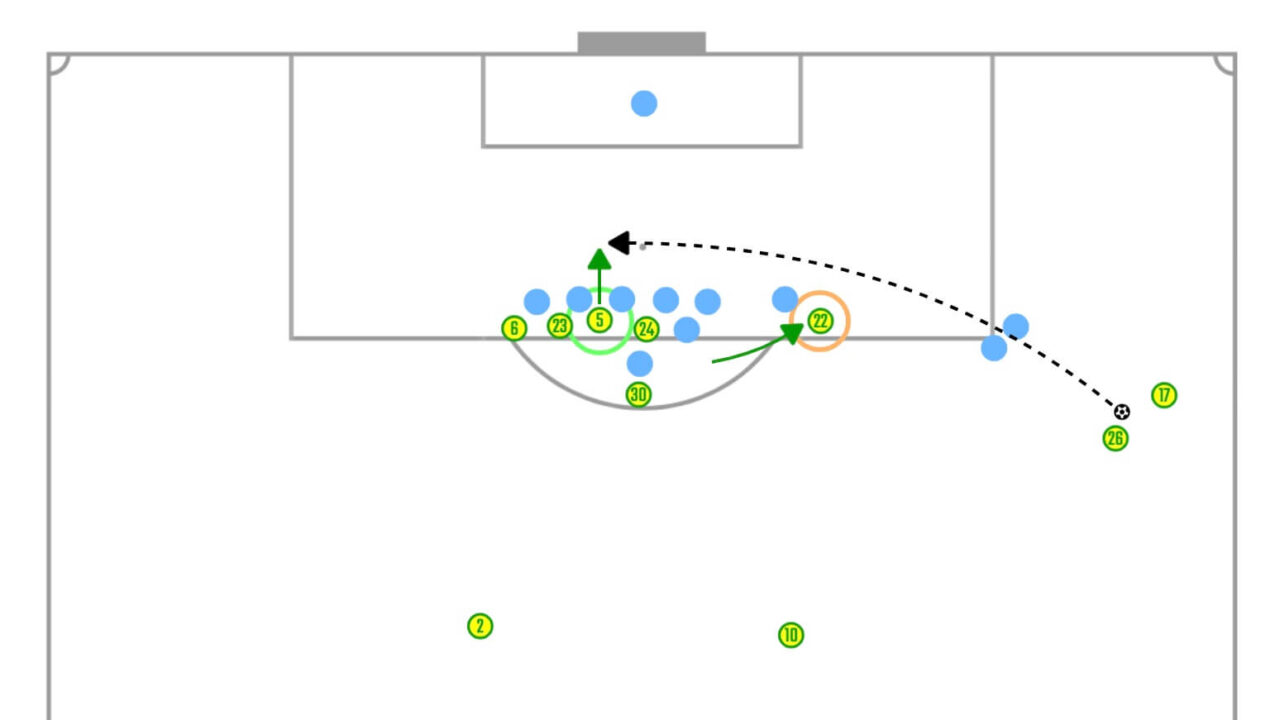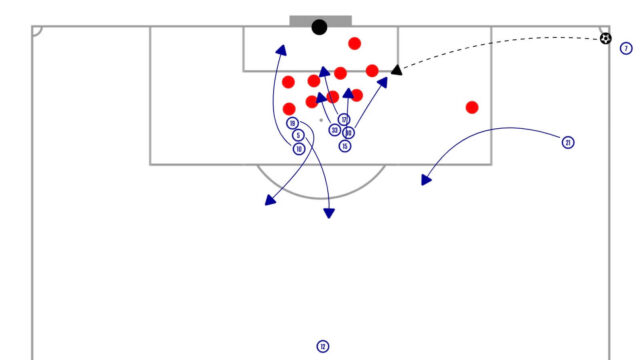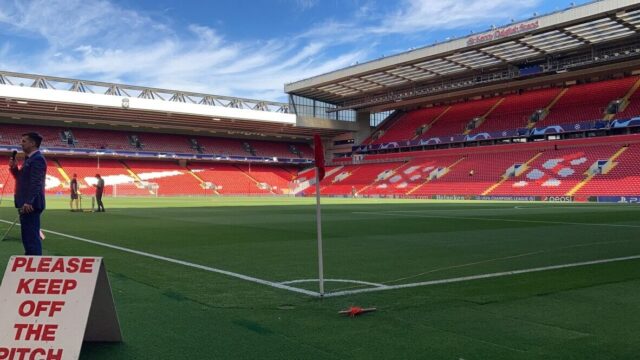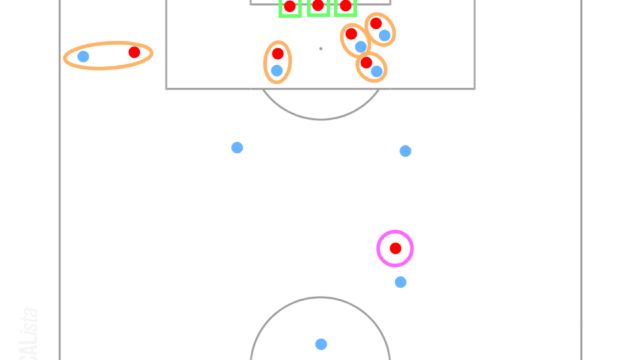Introduction
Despite the short spell at Norwich City, the set piece coach Allan Russell made an impact in EFL Championship. They are not the strongest side of dead ball situations in the league, but they had showed us interesting and basic ideas of both attacking and defending set pieces. In this article, both attacking and defensive tactics of corner kicks and free kicks utilised by Norwich City in 22-23 season until the game against Stoke City on 18th March (due to the availability of the footages) will be analysed.
Before discussing the detail of tactics, let’s take a look at the overall information. Usually the ball is delivered by left-footed Gabriel Sara (17) from both sides in set pieces while right-footed Marcelino Núñez (26) is also considered as a set piece taker. The main target player in the middle is Grant Hanley (5) and another centre back Andrew Omobamidele (4) or Ben Gibson (6) can play the role of flicking the ball at the first post. The defensive midfielder Kenny McLean (23) is also crucial attacker when it comes to set pieces and he also likes to run towards the first post. Additionally, Josh Sargent (24) is also highly involved the routines in the box.
Attacking Corner Kicks
Attacking the First Post
Main objective is, as many teams do, attacking the area around the first post. This is one of the most effective ways in attacking corner kicks because it requires only a flick at the first post and defenders and goalkeeper cannot react it. Additionally, if the ball is delivered to the middle or far side, the possibility of the ball being cleared by one of the opposition defenders will be higher. On the other hand, it becomes much easier to win the first contact if the ball is delivered towards the near side. For those reasons, exploiting the area around the first post is effective. There are some other reasons and they were analysed in the article below with the analysis of Tottenham Hotspur’s tactics of set pieces.
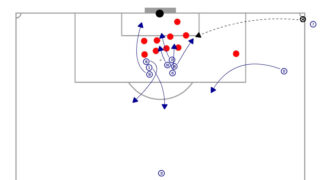
There were various ways to exploit the space at the first post, but the main roles are only two, who try to flick the ball at the first post and tap it into the back of the net in front of the goal.
The first pattern is the combination of an attacker running to the edge of the 6-yard box from the inside of the 6-yard box, an attacker running to the first post from the middle of the18-yard box and a main target player arriving at the space in front of the goal.

When attacking the first post, the deliveries are often fast and in-swing. It helps to make it impossible for the opposition goalkeeper to react to the flicked or deflected balls.
Norwich prepare two players to flick the ball at the near side. In this case, the first player pops up from the inside of the 6-yard box towards the edge of the box. This movement is effective in two ways. Firstly, the run from the blind side of the opposition defenders around the near side is hard for them to react. Therefore, the likelihood that the attacker can reach the ball before the defenders will be high. Secondly, if one of the opposition defenders follows the movement, there will be a gap in front of the first post and this space is the destination of the second attacker to arrive at.
These two players are the initial targets to flick the ball at the first post and if it goes in, that is the perfect scenario. However, the ball often goes wide and the additional attacker to tap or head it in is usually Hanley (5). He always stays in the middle and focuses on the flicked ball in front of the goal.
This structure is the main tactic to exploit the space around the first post but there are various routines. For example, in the illustration above, four attackers in the middle of the 18-yard box are forming two pairs of two attackers. Then, one of the attackers in each pair uses another player as a screen to lose his marker. Not only the tactic of working in pairs but also making split runs from one point is also often used. In this case, these four attackers are positioned tightly together to avoid letting the opposition players mark tightly and each attacker makes a run towards each destination at the same time. To be fair, these two ways are commonly used by almost all teams around the world but there is something unique.
The difference is where attackers start to make a run towards the first post. Usually, attackers position themselves in the middle or far side of the 18-yard box. However, it had been seen that two attackers positioned themselves in the near side of the 18-yard box and made vertical runs towards the edge of the 6-yard box.

In fact, the effectiveness should be analysed well as there were not so many successful examples, but the idea itself is quite unique. The positions in the near side might be harder for the opposition markers to keep their eyes on both the ball and attacker or the vertical run-up might be easier for the attackers to head the ball more precisely or powerfully. It is difficult to know what the aim of this is, but it is worth being mentioned here.
Another way of attacking the first post is that all attackers position themselves inside of the 6-yard box and move towards the edge of the box.

In this case, the dummy player makes a run earlier to drag one of the opposition defenders at the edge of the 6-yard box out to make a gap and the two main target attackers follow the movement. The strength of this pattern is that it is possible to cause chaos in the congested area. Additionally, as the opposition players are forced to come back to the 6-yard box, it is difficult for them to play counterattacks.
Out-swing Deliveries
So far, how to attack the area around the first post with in-swing deliveries was discussed. However, when delivering the ball by out-swing, it is difficult to exploit that area because the ball can go out before reaching the near post area or it is difficult to flick the ball delivered by out-swing. Therefore, when delivering the ball by out-swing, the ball is often delivered to the middle of the box.

It is always the best idea to let the strongest attacker compete in the air. In this situation, the tactics of working in pairs or split runs, which were mentioned earlier, are often utilised to get Hanley (5) to be free. However, he is strong enough to win the aerial duels from just standing still, so he also waits the delivery and then adjusts his position slightly without performing any group tactics.
Short Corner & Tricks
Not only those deliveries but also Norwich had many tricks including short corners or first-time volleys. When playing short or after securing the second balls, they had two aims, which are penetrating deep into the box and delivering the ball towards the back post area.

The taker of the corner kick makes an arced run towards the deep area of the box and the player at the edge of the box offers a passing lane next to the player on the ball. Making an arced run to that area is one of the common movements in Norwich, so it is often seen in the situation like short corners or second phases of attacking corner kicks. Additionally, as soon as the ball is played short or secured after being cleared, main target players move towards the far side, expecting the ball is delivered there. This is the overview of the short corners or second phases of attacking corner kicks.
In terms of creating chances of taking a first-time volley, it is all about how to create the space around the edge of the box. Basically, the attackers in the box make a run towards the goal with leaving the space behind them and the target player outside of the box steps up to take a shot. In this case, the delivery is often straight to make it easier for the target player to meet the ball.
Overall, Norwich’s tactics of attacking corner kicks are various in attacking the first post or trick patterns while simple in delivering by out-swing. The balance between how to work as a team and how to maximise the ability of Hanley (5) seems to be key factors for them and it is beneficial to be able to rely on both of them.
Attacking Free Kicks
The aim of deliveries can differ depending on where they won free kicks. From wide and deep areas, the delivery is in-swing and fast towards the first post or back post, from wide areas but there is a space between defenders and goalkeeper, the delivery is often out-swing towards the middle area and from the middle area, the ball is delivered towards the middle or far side.
Additionally, they often have two takers around the ball. This can confuse the opposition defenders. Not only just it is difficult to expect which in-swing or out-swing the delivery is but also the dummy taker often makes a run in behind or inside to disguise the defenders in the wall. Let’s take a look at the detail of tactics of attacking free kicks.
In-swing & First Post or Back Post
In a deep area, the delivery is fast and in-swing towards the firs post.

This area is similar to corner kicks, so the tactic is also similar to the tactic of attacking corner kicks, which is flicking the fast and in-swing ball at the near side. Target attackers will be Gibson (6) or McLean (23) who like to attack the first post area and run towards that area when both attacking corner kicks and free kicks from deep areas.
Additionally, the ball can be delivered towards the back post area as well.

In this case, the target is Omobamidele (4) or Hanley (5) who are the strangest attacker in the box and they try to head it back in front of the goal. So basically, they have two options when they have a free kick in a deep area.
Out-swing & Middle Area
On the other hand, when the delivery comes from wide and front area, there is a space between the defenders and goalkeeper. In this case, if the delivery is fast and in-swing, attackers cannot reach it at the first post. Therefore, the ball is likely to be delivered by out-swing towards the middle or far area.

This out-swing delivery can help the target attacker to reach the ball and have a power on the header. And the key is obviously delivering the ball beyond the defender at the near side. To disturb the opposition defender there, one of the attackers up front makes a run towards the gap between the inside defenders and wall. This can prevent the opposition defender at the near side from focusing on only clearing the ball, so the probability of the ball reaching the middle might be high.
There is no obvious border between the area of in-swing and out-swing, so it is difficult to expect the type of delivery as Norwich prepare both right-footed and left-footed takers.
From Middle Area to Far Side
When the ball is delivered from the area in front of the 18-yard box, there will be a chance of taking a shot directly, but this time the focus is on where to deliver the ball from the middle area.
Due to the limited angle of delivery, it is difficult for attackers to head the ball towards the goal well in the middle or near side. Therefore, only option is delivering the ball towards the far side to have an angle with out-swing delivery.

In this case, players come close and position themselves in the far side, then one of the target players, Sargent (24) in this illustration, makes an arced run towards the back post while Hanley (5) is still a target attacker in the middle.
Overall, the tactics of attacking free kicks are similar to those of attacking corner kicks when especially delivering the ball from wide and deep area. However, there are more flexibility in terms of the type of delivery as they have two kickers on the ball.
Defending Corner Kicks
The setup of defending corner kicks is a mix of five zonal defenders, four man marking defenders and a defender for short corner. The positions of zonal defenders on the line of the 6-yard box is slightly different depending on in-swing or out-swing deliveries.

Mainly zonal defenders try to step up and clear the ball, but as soon as they realise that it is not for them to reach the ball, they tend to step back to cover the goal. This can be a strength as sometimes one of the defenders blocks the shot on the line, but also a weakness. If the zonal defender, who are mainly centre backs and defensive midfielders, do not step up to clear the ball, it will be a job for man marking defenders, who are smaller players, to compete in the air against the opposition strong attackers. This mismatch can be exploitable. Additionally, as the zonal defenders step back to the goal, there will be a gap inside of the 6-yard box. This can give space and time for the opposition attacker to tap the ball in after it was headed back from the far post.
Another weakness is the far side zonal defender, McLean (23). It is naturally difficult for the defender at the far post to clear the ball with stepping back when the ball is delivered there, but he often loses the aerial duels against the opposition attacker. Many teams try to exploit that area, so he had to face the strongest opposition attacker. Therefore, it is tough for him to demand to win all duels, but this characteristic of zonal defending which the opposition team can plan who to target at should be noted here.
In terms of short corners, if there is only a taker around the corner, it will be a job for the player at the edge of the box because he is marking the opposition player to receive the short corner. In case of there are two players around the corner or one of the opposition attackers inside of the box offers the short corner, Max Aarons (2) who is positioned at the first post will step out to deal with the short corner. After this, the situation is a 2v3, so to support this, Sara (17) will also come out to make it 3v3.

Defending Free Kicks
When defending free kicks, they set a quite high line to defend but it is also a mix of zonal and man marking. Both centre backs stay in the middle and defend zonally, stepping back earlier than other players. And in some cases, the opposition main attackers are marked by some Norwich defenders who play a role of man marking when defending corner kicks. However, they respect the back line and try to keep the opposition attacker offside if they move beyond the line.

Thanks for reading. I hope you enjoyed this.
